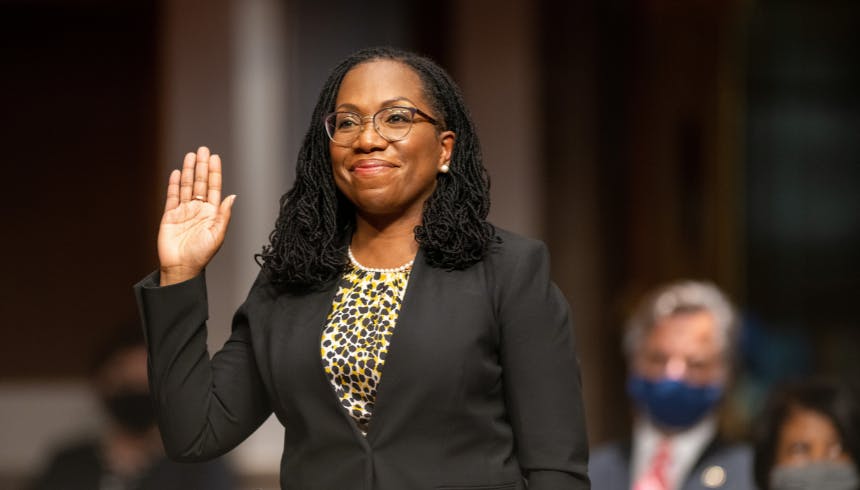On March 22, day one of Judge Kentaji Brown Jackson’s confirmation hearings to become the first Black, female Supreme Court Justice began.
Of the many journalists and photojournalists that were there to document the day, it was one photograph by Sarabeth Maney, a Black, female photojournalist from The New York Times, that captured the essence of what the moment meant.
On the left side of the frame we see Jackson smiling, but out of focus, forcing our eyes right and backward to a seat just feet behind her. Her daughter Lelia, 17, sat back with a warm smile on her face and admiration in her eyes, as she watched her mom trailblaze through history. The image embodied pride. It embodied joy. It embodied hope.
Maney said in a lot of ways, she was documenting what she herself felt in the moment.
“Being in that room, I understood a little of what Judge Jackson was going through,” Maney told TIME magazine. “I know what it takes to make a place for myself in spaces that were not designed for me.”
To make a place.
When Maney shared her photo to the world for the first time on Instagram, she accompanied it with the caption, “Being the first often means you have to be the best – and the bravest.”
On Nov. 3, 2020, Kamala Harris became the first Black woman elected to the White House as vice president.
On Nov. 2, 2021, Ron Bacon was elected East Lansing mayor, becoming the city’s first Black mayor.
On April 8, with a confirmation vote of 53-47, Jackson became the first Black, female Supreme Court Justice, shattering the glass ceiling in the Supreme Court.
These accomplishments by the Black community are worthy of their celebration. However, the fight for racial and ethnic diversity in the most powerful seats on the local, state and federal level continues.
Representation is only the first step down a long path to ensuring racial justice and equity in the United States; nationally and locally.
East Lansing is not excluded. You are not excluded.
With Black and Brown communities making up about 25% of the total East Lansing population, and about 17% of Michigan State University’s campus, we have to continue to push for more equal representation not only among our legislative bodies, but in our classrooms, organizations, workplaces and more.
At The State News, we’re always focused on diversity and inclusion, both in our coverage and in the staff that provides said coverage. In the past two years, we created and fine-tuned our culture desk to bridge that gap in content, while creating a semesterly diversity report to track internal efforts.
We acknowledge The State News isn’t perfect.
Our goal isn’t to give a voice to the voiceless. This statement has been thrown around often and it is an ignorant one to say the least. No one is voiceless. Everybody has a voice, a story and their own set of lived experiences they use to shape their perceptions of the world around them.
To give platform and agency in the hopes that it might ultimately amplify these voices is our mission. And it is an ongoing effort.
The university has made some strides: Incoming students are required to take an online Diversity, Equity and Inclusion course before attending MSU. Also, after administration was presented with a 10-point plan to implement more DEI initiatives, the university is planning to create a campus multicultural center on campus.
But MSU isn’t perfect either — multiple racist events have occured on campus just in the last three years, including someone hanging a toilet paper noose on one Black student’s door and a professor sending out a survey that used blatant racial stereotypes. Students like those in the James Madison College have outwardly spoken about the lack of representation in their classrooms.
Support student media!
Please consider donating to The State News and help fund the future of journalism.
After centuries of being excluded from positions of power, both legally and socially, Black and Brown communities are beginning to find their way into important seats. As this momentum grows, it’s important that the strides toward equality and equity follow on a more local level.
We cannot let the recent achievements of Harris, Bacon, Jackson and others allow us to become complacent.
Diversity doesn’t start or end in the White House. It starts at the community level.
It starts with the recognition that knowledge is power, education is access and that we all have the means to utilize these tools. Especially at Michigan State University. It starts in the various dormitories and academic halls filled with students who, all together, make up the green and white.
The work is far from being done.
The State News Editorial Board is composed of Editor-in-Chief Karly Graham, Managing Editor Jayna Bardahl, Campus Desk Editor Wendy Guzman, City Desk Editor Griffin Wiles, Culture Desk Editor Noah Edgar, Sports Desk Editor Eli McKown, Copy Chief SaMya Overall, Multimedia Editors Devin Anderson-Torrez and Rahmya Trewern, Social Media Manager Stephanie McCullum, Staff Rep. Morgan Womack and Diversity Rep. Raenu Charles.
This story was in our April 12 print edition. Read the full issue here.
Discussion
Share and discuss “EDITORIAL: As Jackson and others make history, we acknowledge representation is the minimum” on social media.





